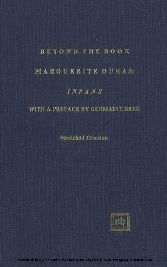Suchen und Finden
INTRODUCTION (p. 4)
"True novels are poems." —Marguerite Duras
Le Monde exterieur, 1933
Reviewing Marguerite Duras` occasional pieces of the last thirty years (newspaper articles, political and artistic reflections, prefaces, etc.) recently published as Le Monde exterieur: Outside 2 (1993), John L. Brown of Washington, D.C., concludes: "It is doubtful whether the volume could contribute appreciably to Marguerite Duras`s reputation as a significant cultural phenomenon of contemporary France.
However, it will provide a few additional scraps of information for the still-flourishing Duras academic industry." Professor Brown reminds us that more than 200 Duras theses have been defended in France and the United States, and some 300 articles of Duras scholarship published.
There is no doubt that, at least since the "autofictions" of the 1980s, and, more specifically, since 1984, when L`Amant won for her the prestigious Prix Goncourt, Marguerite Duras has been a household name among the intelligentsia of Europe and the United States.
A succes de scandale (and, by all accounts, a commercial success as well), the film version of The Lover extended her fame to a viewing public outside the "academic industry."
In France, furthermore, her ready access to the media established for Duras a well-known paratextual identity via press and television, translated to the larger following of international readers in collections such as Les Lieux de Marguerite Duras (1977), La Vie materielle, and the two Outside volumes (1984, 1993), all of which helped turn the author into what Marilyn Schuster has called "a national monument in popular culture" (ix).
It might, then, be argued that Duras the public persona outdistanced the creative artist in her bid for recognition, and that our increased attention to her works from the 1980s is directly related to their autofictive nature which intricately interweaves life and art, and continues to divide into equally vociferous "Durasophobes" and "Durasophiles" the many visitors to the country of Durasia.
Following her death on 3 March 1996, both Jean-Claude Lamy of Le Figaro (4 March), and Francois Nourissier in Le Figaro Magazine referred to Duras` stature as that of a monstre sacre equal, said the latter, to the Sartrian legend.
Much of the "Duras industry" has focused on psychological probings that use her texts as pretexts for Freudian, Lacanian, or Kristevan analyses. Indeed, Lacan and Kristeva themselves, fascinated by the complex phenomenon of the Duras persona, have devoted extensive studies to her work.
The author, meanwhile, found herself both "baffled" and intrigued by Lacanian statements like, "She must not know that she`s writing what she writes. Because she would lose herself. And that would be a catastrophy."
Duras` articulation of deeply personal struggles (with alcoholism, alienation, depression, madness, mother/daughter relationships, incest), and her championing of public causes like racial, sexual, and gender equality, are indeed part of a significant cultural phenomenon not only of contemporary France, but of the postwar world as we know it.
Alle Preise verstehen sich inklusive der gesetzlichen MwSt.







